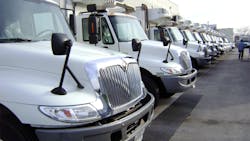Company: E.A. Sween Co., Eden Prairie, MN
Operation: Sandwich and pastry maker and distributor, including cold and hot products and "roller grill" burritos, pizzas, and more. E.A. Sween serves retail and wholesale customers such as supermarkets, convenience stores, and vending machine companies.
Problem: Time-consuming old processes were limiting operational efficiency.
E.A. Sween's Combined Distribution Center (CDC) division is ahead of the curve when it comes to the delivery business. Helping reduce truck congestion, the division pools together snack, sandwich, beverage, and other food deliveries at its large distribution hubs and then brings them all on a single truck to customers, based on order.
The CDC division can also make its deliveries "in the wee hours" so that trucks travel when there's much less traffic. It's an efficient model that matches up well with a company delivering, after all, efficient meals you can grab on the go.
For such a forward-thinking business, though, its drivers were relying on manual processes not that long ago.
"It was all done on paper," explains Robert Forte, now vice president of the CDC division. "The driver would get to a stop, write down what time they got there, the mileage, the temperature of the airflow, the number of totes going in.
"The driver would bring that product into the store, someone would sign for it, then the driver would get back in the truck, write down the time out, and go to the next stop," he continues. Taking down all the delivery information by hand also had E.A. Sween's trucks idling longer as drivers completed each stop.
It slowed down each stop as well, contributing to overall park time for trucks. Minutes add up to hours upon hours for a fleet over time, and it all means money lost and less-efficient operations than might be achieved—and E.A. Sween now knows exactly how much.
Solution: Implement fleet management functionality from Coretex and challenge drivers to improve processes.
It was back around 2011 that E.A. Sween began upgrading data-entry processes as part of its fleet management systems. The company found solutions from Coretex to be user-friendly and intuitive compared with others it considered.
The first issue to address was truck idle times. Prior to using Coretex systems, that was measured more anecdotally. Fuel was at about $5.00 a gallon at the time, and Forte calculated that the CDC division could save some $300,000 annually by cutting out unnecessary idling.
He was right. First came visibility: the Coretex system reported trucks' idle times on a daily basis, so the company could now keep after drivers if they weren't shutting off trucks. The CDC division even geofenced delivery locations to limit idling as much as possible.
"We pushed it to the point where once we saw that a driver had hit a geofence, we'd give them one minute to shut the engine off," Forte recalls. "We got our return on investment in the Coretex solution in a number of months just by focusing on that idle time."
Remarkably, the CDC division's idle times plummeted from more than 90% per asset to 10%. But Forte also wanted to target overall park/stop times, projecting the company could save $80,000-$100,000 per year by reducing those by 2 minutes.
He used the Coretex system to develop a chart that showed drivers their average stop times, and they were challenged to cut their time down as much as possible.
"With that data, we went from 21 minutes average stop time per day and we knocked that down under 18 minutes per day," Forte says. Well beyond the targeted savings, "we were able to realize cost savings of over $200,000," he notes.
E.A. Sween first deployed the Coretex technology in Chicago and has expanded that across multiple states. And to streamline operations and boost efficiencies further, it has been adding more functionality such as electronic signature/delivery tracking, which, meanwhile, has also helped cut down on a previous loss item by keeping tabs on returnable plastic containers.
About the Author
Fleet Owner Staff
Our Editorial Team
Kevin Jones, Editorial Director, Commercial Vehicle Group
Cristina Commendatore, Executive Editor
Scott Achelpohl, Managing Editor
Josh Fisher, Senior Editor
Catharine Conway, Digital Editor
Eric Van Egeren, Art Director
